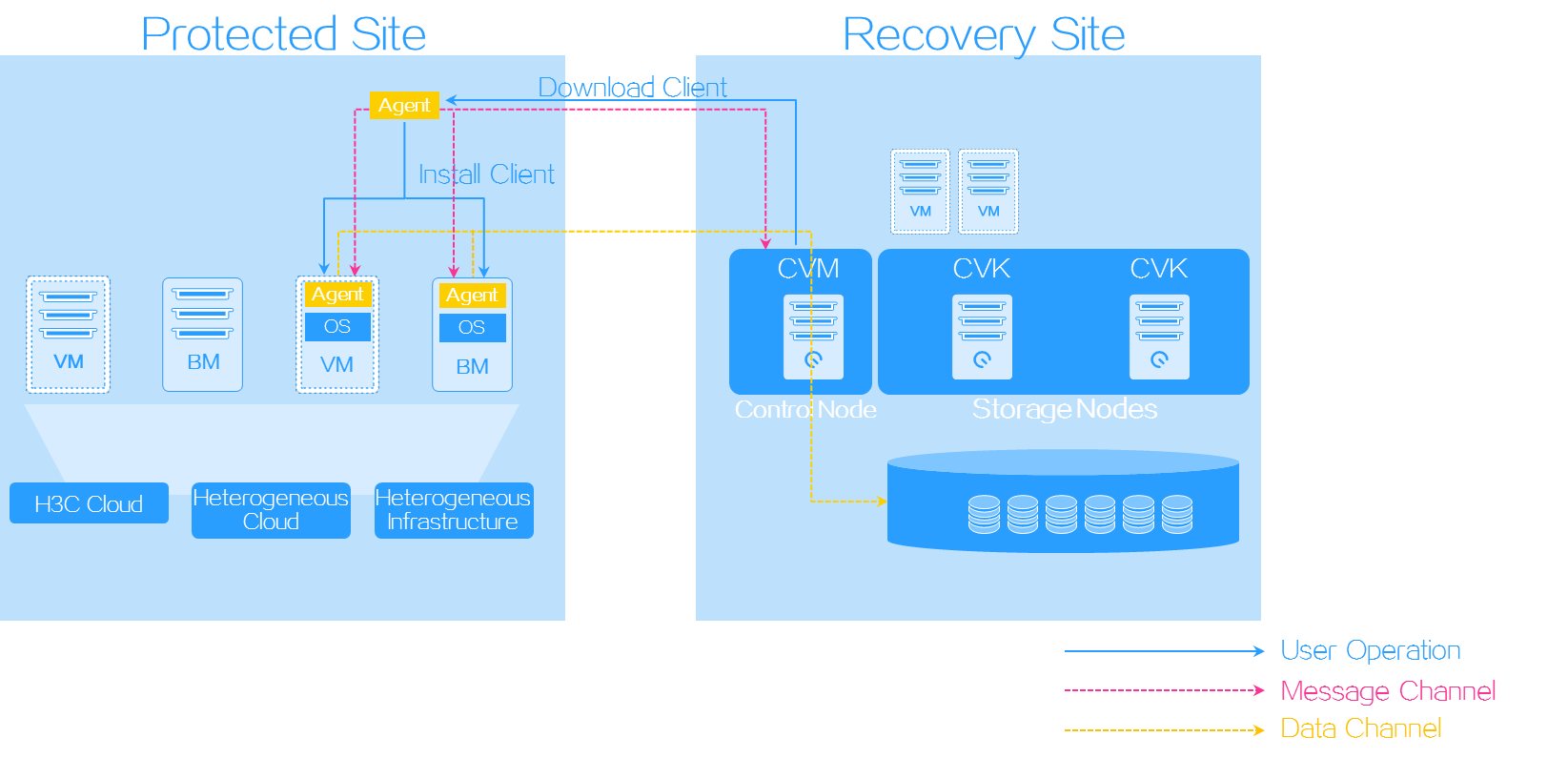Configure disk backup-based disaster recovery
Disk backup-based disaster recovery protects VMs or bare metal servers installed with the disaster recovery client. The real-time disk replication feature of the disaster recovery client copies data of protected objects by operating system to the recovery site for DRM to restore the protected objects as VMs.
Disk backup-based disaster recovery uses CDP to replicate operating system data for disaster recovery. DRM obtains host information and captures data block changes from the CDP agents installed on the hosts where protected objects reside, and transmits incremental data to the storage nodes on the recovery site.
With the snapshot chain and real-time synchronization mechanisms, data can be backed up and synchronized in seconds to satisfy the requirements of high-performance RPO data recovery. Disk backup-based disaster recovery supports backing up services of multiple cloud platforms with different infrastructure on one recovery site. It can be used in all application scenarios of DRM.
Application scenarios
Disk backup-based disaster recovery is applicable to the following scenarios:
Homogeneous clouds—The same CAS CVM version is deployed on the protected and recovery sites, and the protected objects are VMs.
Heterogeneous clouds—CAS CVM is deployed on the recovery site, and one of the following conditions exists on the protected site:
The protected VMs are running on a non-CAS cloud platform.
The CAS CVM version of the protected site is lower than that of the recovery site.
The protected objects are bare metal servers.
Hybrid infrastructure—CAS CVM is deployed on the recovery site, and the protected site accommodates both VMs and bare metal servers.
Disk backup-based disaster recovery can reduce RPO and RTO to minutes.
Configuration environment
Storage—Not requirements.
Projected site—x86 cloud platforms, or physical servers.
Recovery site—CAS Enterprise or Enhanced Enterprise Edition with DRM licensed, E0536 and later.
Operating system of protected nodes—Windows Server or Linux.
Compatibility with Linux operating systems depends on the kernel version. For a Linux operating system whose kernel is not in the matrix, select a CDP driver with the closest kernel version. For example, you can install the CDP driver for Redhat4.7 x32 with kernel cdp_2.6.9-78.EL.ko on Redhat4.5 x32 with kernel 2.6.9-55.EL.
Table-1 OS compatibility matrix
|
Category |
Operating system version |
|
Windows |
Windows Server 2003 X86/X64 |
|
Windows Server 2008 X86/X64 |
|
|
Windows Server 2008 R2 X64 |
|
|
Windows Server 2012 X64 |
|
|
Windows Server 2012 R2 X64 |
|
|
Windows Server 2016 |
|
|
Redhat |
Redhat 4.2 i386 (2.6.9-22ELsmp) |
|
Redhat 4.2 i386 (2.6.9-22.EL.ko) |
|
|
Redhat 4.3 i386 (2.6.9-34.21AXsmp.ko) |
|
|
Redhat 4.6 x64 (2.6.9-67.ELlargesmp_x64.ko) |
|
|
Redhat 4.7 x32 (2.6.9-78.EL.ko) |
|
|
Redhat 4.7 x32 (2.6.9-78.ELsmp.ko) |
|
|
Redhat 4.7 x64 (cdp_2.6.9-78.EL_x64.ko) |
|
|
Redhat 4.7 x64 (2.6.9-78.ELsmp_x64) |
|
|
Redhat 5 x32 series (2.6.18-8.el5.ko) |
|
|
Redhat 5 x64 series (2.6.18-8.el5_x64.ko) |
|
|
Redhat 6.0 x32 series (2.6.32-71.el6.i686) |
|
|
Redhat 6.0 x64 series (2.6.32-71.el6.x86_64) |
|
|
Redhat 6.2 x32 (2.6.32-220.el6.i686.ko) |
|
|
Redhat 6.2 x64 (2.6.32-220.el6.x86_x64.ko) |
|
|
Redhat 7.0 x64 (3.10.0-123.el7.x86_64) |
|
|
Redhat 7.1 x64 (3.10.0-229.el7.x86_64) |
|
|
Redhat 7.2 x64 (3.10.0-327.el7.x86_64) |
|
|
Centos |
Centos 6 x32 series (2.6.32-71.el6.i686) |
|
Centos 6 x64 series (2.6.32-71.el6.x86_64) |
|
|
Centos 7.0 x64 (3.10.0-123.el7.x86_64) |
|
|
Centos 7.1 x64 (3.10.0-229.el7.x86_64) |
|
|
Centos 7.2 x64 (3.10.0-327.el7.x86_64) |
|
|
Oracle Linux |
OracleLinux-R6-U3-x64 (2.6.39-200.24.1.el6uek.x86_64.ko) |
|
Kylin |
Kylin-4.0-1E-desktop_20160401-final-x86_64 (3.16.0-23-generic) |
|
NeoKylin-Linux-Advanced-Server-6.7 (2.6.32-573.el6.x86_64) |
|
|
NeoKylin-sws-3.2(64) (2.6.32-220.2.1.2.ky3.2.x86_64) |
|
|
YHKylin-4.2-5-x86_64-server (2.6.32-431.29.2.3.ky3.1.x86_64) |
|
|
Suse |
SUSE Linux Enterprise Server 10 SP2 x86 (2.6.16.60-0.21-bigsmp) |
|
SUSE Linux Enterprise Server 10 SP2 x86 (2.6.16.60-0.21-default) |
|
|
SUSE Linux Enterprise Server 10 SP2 x64 (2.6.16.60-0.21-default) |
|
|
SUSE Linux Enterprise Server 10 SP2 x64 (2.6.16.60-0.21-smp) |
|
|
SUSE Linux Enterprise Server 10 sp3 x64 (2.6.16.60-0.54.5-smp_x64) |
|
|
SUSE Linux Enterprise Server 11 SP2 x64 (3.0.13-0.27-default) |
|
|
Suse Linux Enterprise Server 11 sp3 x86 (3.0.76-0.11-pae) |
|
|
Suse Linux Enterprise Server 11 sp3 x64 (3.0.76-0.11-default) |
|
|
Suse Linux Enterprise Server 11 sp3 x64 (3.0.101-0.31-default_x64) |
|
|
Suse Linux Enterprise Server 12 sp2 x64 (4.4.21-69-default_x64) |
|
|
Ubuntu |
Ubuntu-12.04 x64 (3.13.0-117-generic) |
|
Ubuntu-14.10 x64 (3.16.0-23-generic) |
Mechanisms
DRM protects VMs or bare metal servers (or referred to as production nodes) installed with the disaster recovery client. The real-time disk replication feature of the disaster recovery client copies data of protected objects by operating system to the recovery site for DRM to restore the protected objects as VMs.
|
For CAS to identify CentOS VMs correctly and perform disk backup-based disaster recovery, configure correct network settings for CentOS VMs. |
Figure-1 Disk backup-based disaster recovery procedure
